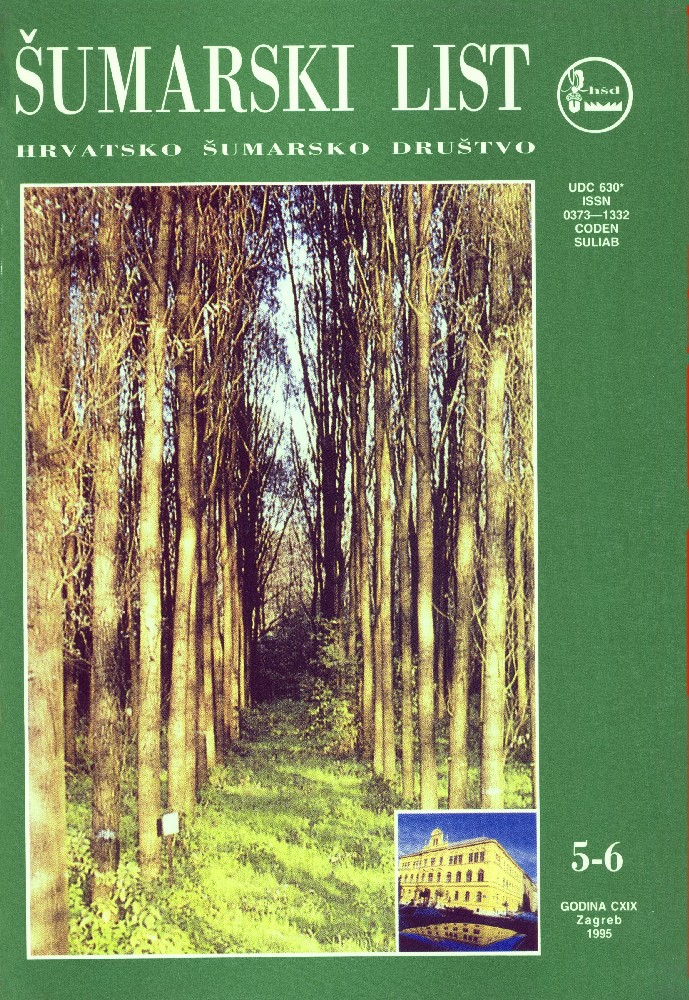
broj: 5-6/1995
pdf (13,5 MB) |
|
||||||||||||||
| IZVORNI ZNANSTVENI ČLANCI | ||
| Krstinić, A., Kajba, D. | UDK 630*232.275.2 (Salix sp.) | |
| First Results of Arborescent Willow Improvement by Seifing, Back Cross and Transgression pdf HR EN | 163 | |
| Summary: To meet the requirements of biomass production in short rotations, the White Willow (Salix alba L.) has been crossed with the Chinese Willow (Salix matsudana Koidz.). For the first time the improvement methods of selfing, back cross and transgression have been used. Crossing of the Chinese, tortuous Willow (Salix matsudana f tortuosa Koidz.) with the autochtonous White Willow produced interspecific hybrids which in higher percentage were monoecious. By selfing the hybrids 25 plants have been raised. Due to their poor vitality, the only one survived plant was male and was used to obtain pollen for hybridization. Back crosses of F´ generation hybrids were made on the Chinese Willow, while for the production of F2 generation hybrids, the genetically divergent (New Zealand, Croatia) hybrids Salix matsudana x Salix alba were used. Improvement by hybridization using selfing, back cross and transgression proved that on the basis of transgression plus variants can be produced with respect to biomass. Using a mentioned improvement methods, a large number of minus variants also became differentiated in the progeny. Phenotypically, in addition to dwarfness size, they show the characteristics which occured as the result of the appearance of atavisms (such as small narrow leaves, small stem and branchlets covered with periderm, etc.) thus being suitable for arborescent Willow evolution studies. Cloning plus variant it was possible, in the produced families, to make selection of new genotypes of Arborescent Willows that will be suitable for biomass production in short rotations. Morphologically aberrant minus variants can be used in horticulture. Key words: Arborescent Willows; biomass; improvement by selfing; back cross and transgression | ||
| Komlenović, N., Orlić, S., Rastovski, P. | UDK 630*232.564 (Coniferae sp.) | |
| Growth and Biomass Production of Six Coniferous Species in Fern and Heath Areas of Croatia pdf HR EN | 169 | |
| PRETHODNO PRIOPĆENJE | ||
| Šajković, A. | UDK 630*301.085(497.13) | |
| Forestry Students´Attitudes Toward Development and Protection of Environment pdf HR EN | 179 | |
| STRUČNI ČLANCI | ||
| Stojković, M. | UDK 630*442 (Ulmus minor Mill.) (497.13) | |
| Pershing of Elm Field (Ulmus minor Mill., sin. Ulmus carpinifolia Suckow) in the ex-Prigorje Zagorje Region pdf HR EN | 183 | |
| Piškorić, O. | UDK 630*902(497.13) | |
| The Hundredth Anniversary of the Laws on Forest Management of Croatia pdf HR EN | 189 | |
| Tonković, D. | UDK 630*902(497.13) | |
| Štirovača as a Former Centre for Wood Conversion of Central Velebit pdf HR EN | 201 | |
| Starčević, T. | UDK 630*95 | |
| Statute on Forest Management. To Implement or to Change? PDF | 207 | |


